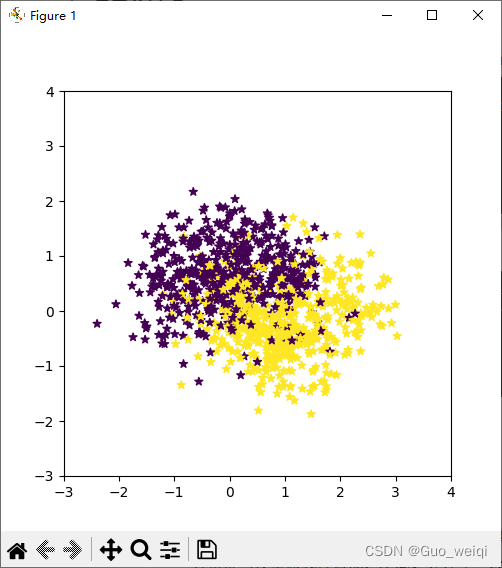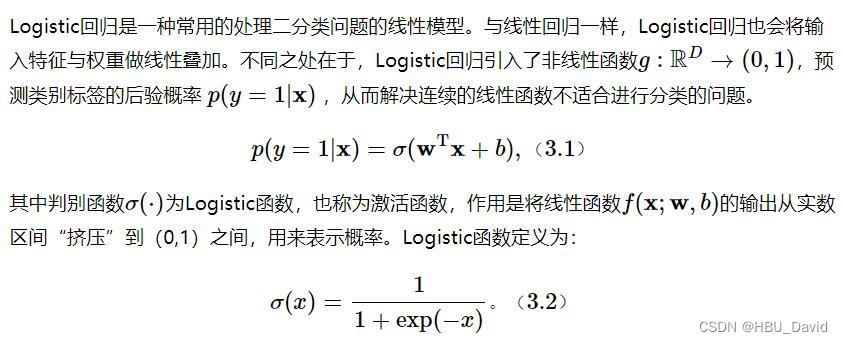第3章 线性分类
3.1 基于Logistic回归的二分类任务
3.1.1 数据集构建
构建一个简单的分类任务,并构建训练集、验证集和测试集。
本任务的数据来自带噪音的两个弯月形状函数,每个弯月对一个类别。我们采集1000条样本,每个样本包含2个特征。
随机采集1000个样本,并进行可视化。
将1000条样本数据拆分成训练集、验证集和测试集,其中训练集640条、验证集160条、测试集200条。
import math
import torch
import matplotlib.pyplot as plt
def make_moons(n_samples=1000, shuffle=True, noise=None):
"""
生成带噪音的弯月形状数据
输入:
- n_samples:数据量大小,数据类型为int
- shuffle:是否打乱数据,数据类型为bool
- noise:以多大的程度增加噪声,数据类型为None或float,noise为None时表示不增加噪声
输出:
- X:特征数据,shape=[n_samples,2]
- y:标签数据, shape=[n_samples]
"""
n_samples_out = n_samples // 2
n_samples_in = n_samples - n_samples_out
# 采集第1类数据,特征为(x,y)
# 使用'torch.linspace'在0到pi上均匀取n_samples_out个值
# 使用'torch.cos'计算上述取值的余弦值作为特征1,使用'paddle.sin'计算上述取值的正弦值作为特征2
outer_circ_x = torch.cos(torch.linspace(0, math.pi, n_samples_out))
outer_circ_y = torch.sin(torch.linspace(0, math.pi, n_samples_out))
inner_circ_x = 1 - torch.cos(torch.linspace(0, math.pi, n_samples_in))
inner_circ_y = 0.5 - torch.sin(torch.linspace(0, math.pi, n_samples_in))
print('outer_circ_x.shape:', outer_circ_x.shape, 'outer_circ_y.shape:', outer_circ_y.shape)
print('inner_circ_x.shape:', inner_circ_x.shape, 'inner_circ_y.shape:', inner_circ_y.shape)
# 使用'torch.cat'将两类数据的特征1和特征2分别延维度0拼接在一起,得到全部特征1和特征2
# 使用'torch.stack'将两类特征延维度1堆叠在一起
X = torch.stack(
[torch.cat([outer_circ_x, inner_circ_x]),
torch.cat([outer_circ_y, inner_circ_y])],
dim=1
)
print('after concat shape:', torch.cat([outer_circ_x, inner_circ_x]).shape)
print('X shape:', X.shape)
# 使用'torch. zeros'将第一类数据的标签全部设置为0
# 使用'torch. ones'将第一类数据的标签全部设置为1
y = torch.cat(
[torch.zeros(size=[n_samples_out]), torch.ones(size=[n_samples_in])]
)
print('y shape:', y.shape)
# 如果shuffle为True,将所有数据打乱
if shuffle:
# 使用'torch.randperm'生成一个数值在0到X.shape[0],随机排列的一维Tensor做索引值,用于打乱数据
idx = torch.randperm(X.shape[0])
X = X[idx]
y = y[idx]
# 如果noise不为None,则给特征值加入噪声
if noise is not None:
# 使用'torch.normal'生成符合正态分布的随机Tensor作为噪声,并加到原始特征上
X += torch.normal(mean=0.0, std=noise, size=X.shape)
return X, y
# 采样1000个样本
n_samples = 1000
X, y = make_moons(n_samples=n_samples, shuffle=True, noise=0.5)
# 可视化生产的数据集,不同颜色代表不同类别
plt.figure(figsize=(5,5))
plt.scatter(x=X[:, 0].tolist(), y=X[:, 1].tolist(), marker='*', c=y.tolist())
plt.xlim(-3,4)
plt.ylim(-3,4)
plt.savefig('linear-dataset-vis.pdf')
plt.show()
num_train = 640
num_dev = 160
num_test = 200
X_train, y_train = X[:num_train], y[:num_train]
X_dev, y_dev = X[num_train:num_train + num_dev], y[num_train:num_train + num_dev]
X_test, y_test = X[num_train + num_dev:], y[num_train + num_dev:]
y_train = y_train.reshape([-1,1])
y_dev = y_dev.reshape([-1,1])
y_test = y_test.reshape([-1,1])
# 打印X_train和y_train的维度
print("X_train shape: ", X_train.shape, "y_train shape: ", y_train.shape)
# 打印一下前5个数据的标签
print (y_train[:5])outer_circ_x.shape: torch.Size([500]) outer_circ_y.shape: torch.Size([500])
inner_circ_x.shape: torch.Size([500]) inner_circ_y.shape: torch.Size([500])
after concat shape: torch.Size([1000])
X shape: torch.Size([1000, 2])
y shape: torch.Size([1000])
X_train shape: torch.Size([640, 2]) y_train shape: torch.Size([640, 1])
tensor([[1.],
[1.],
[0.],
[1.],
[1.]])
3.1.2 模型构建

import torch
import matplotlib.pyplot as plt
def logistic(x):
return 1 / (1 + torch.exp(-x))
# 在[-10,10]的范围内生成一系列的输入值,用于绘制函数曲线
x = torch.linspace(-10, 10, 10000)
plt.figure()
# tolist()用于将数组或矩阵转为列表
plt.plot(x.tolist(), logistic(x).tolist(), color="#e4007f", label="Logistic Function")
# 设置坐标轴
ax = plt.gca()
# 取消右侧和上侧坐标轴
ax.spines['top'].set_color('none')
ax.spines['right'].set_color('none')
# 设置默认的x轴和y轴方向,坐标原点
ax.xaxis.set_ticks_position('bottom')
ax.yaxis.set_ticks_position('left')
ax.spines['left'].set_position(('data', 0))
ax.spines['bottom'].set_position(('data', 0))
# 添加图例
plt







 最低0.47元/天 解锁文章
最低0.47元/天 解锁文章














 1567
1567











 被折叠的 条评论
为什么被折叠?
被折叠的 条评论
为什么被折叠?








